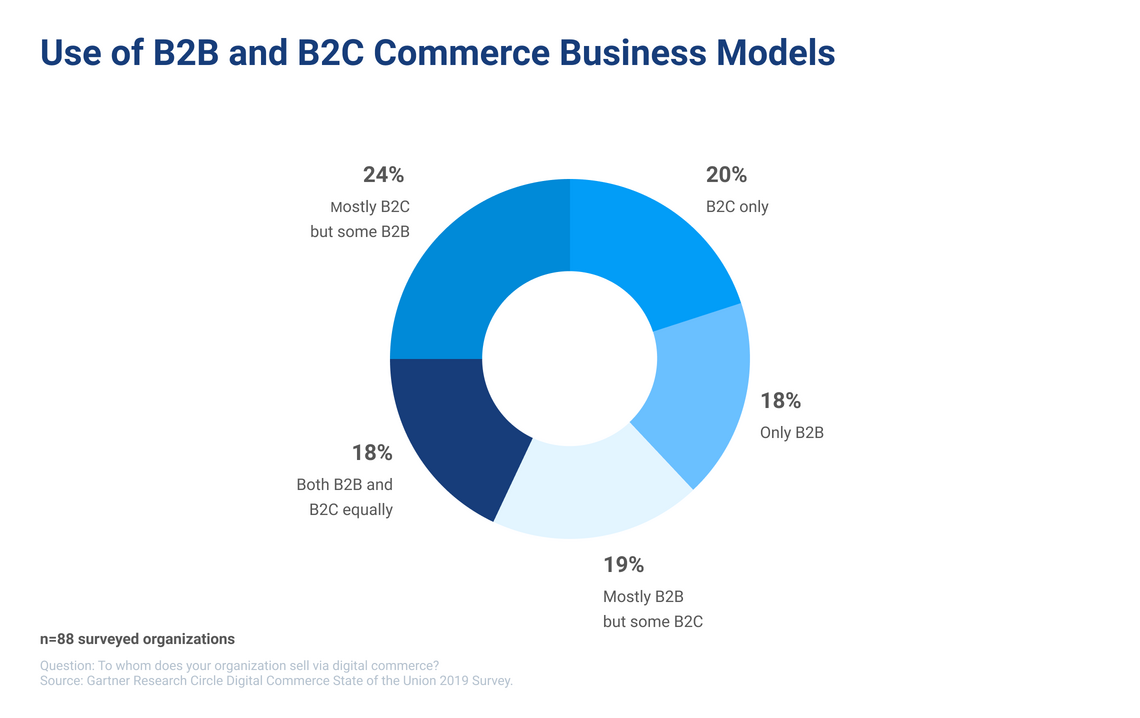Get in touch
As rapidly as markets, customer needs, and technological possibilities are changing, to be future-proof, retailers need to be as flexible as possible with their digital commerce solution. This means moving away from questions such as "buy or build" and "B2C or B2B" and instead taking advantage from the best of all worlds.
Keeping all options open as an online retailer – this can affect different levels. On the one hand, when it comes to selecting an E-Commerce shop system, retailers often still have a "buy or build" mindset: They either buy a ready-made standard solution or build their own one individually. On the other hand, most retailers are limited and fixed in terms of their target group and take either a B2B or a B2C approach.
If you take a look at the E-Commerce shop systems and digital platforms available for retail, the first question that comes to mind is this one: Standard solution or custom-built? That is, a new development that is tailored precisely to your requirements. Both approaches have advantages and disadvantages that have to be weighed against the background of your own requirements. These differ sharply especially with regard to implementation speed and flexibility: Normally a standard solution can be put to use more quickly, but it is much less flexible with respect to new functions, adjustments, and the integration of other systems.
But how would it be if retailers didn’t even have to ask themselves the question “buy or build”? The market research and consulting company Gartner has observed a change toward “buy and build,” that is, a combination of both. Companies are increasingly beginning to purchase part of their commerce platforms ready-made, but then expand or adapt them and add newly developed functions. Approximately half of the companies surveyed in 2019 in “Survey analysis: 9 Key Trends in Digital Commerce Adoption” rely on “buy and build,” whereby 30% develop the majority themselves and 19% start with Open-Source software as the basis. By contrast, only 20% rely completely on a standard, stand-alone solution.

This is a clever procedure, especially for the requirements of retail, since it enables initial implementation as well as great flexibility and adaptation to niche markets – and constant adaptation according to the needs of the markets and customers.
Gartner also recommends to companies that they should create their digital platform as a marketplace; that is, so that it can accommodate the needs of all target groups, even if they are not currently being served. In addition to end customers and business customers, this might also include partners and employees, for example.
The majority of the companies surveyed in the “Survey analysis: 9 Key Trends in Digital Commerce Adoption” relied at the time of the survey on a pure B2B or B2C approach for their digital business. Just 18% generated the same percentage of their digital commerce sales via B2B and B2C.

There is a lot of potential for retail here: Through an expansion of the business model beyond the original target group, potential for long-term revenue sources can be exploited. This way, for example, pure B2B retailers can use a digital marketplace model to address end customers directly and thereby ensure customer loyalty.
Of course this takes a digital solution that can fulfill both business models’ requirements. For if all digital business can be controlled via a central platform and if all data comes together in one solution, the company can save time and money and business processes can be considered across target groups and channels.
For operators of an online platform it is important first and foremost to be aware of your own requirements and goals and to select the technological solution according to the extent to which it can address these. Possible factors that can be of varying relevance for different retailers are, for example:
Implementation speed
From the final decision to the actual go-live, how long will it take to be able to use the new system? New development, customization (that is, adjustment), and individual developments can take some time depending on the implementation form, which means that such a platform for retailers will require more lead time than a standard solution.
Flexibility & integration of new features
Implement new functions quickly, adjust and optimize; if necessary, discard and try something new: If a retailer truly wants to focus on end customers and fulfill all of their needs, the shop system has to be flexible and able to react at any time to market fluctuations and the customers’ requirements and allow to take new innovational technologies into account.
Integration of other applications
Payment, logistics, CRM, contract management, product catalogs: What other systems have to be integrated into the new platform, perhaps just at first, perhaps permanently? If a technological solution can do this easily, that's a win.
Nobody can look into the future. What's certain is that the technological possibilities will keep changing, and therefore digital retail will keep facing new challenges. Retailers that are open to new business opportunities, such as a marketplace model with different target groups, and whose digital solution is prepared for this, may have the crucial competitive advantage.
This article first appeared in the magazine "etailment". We appreciate your feedback and sharing the article.